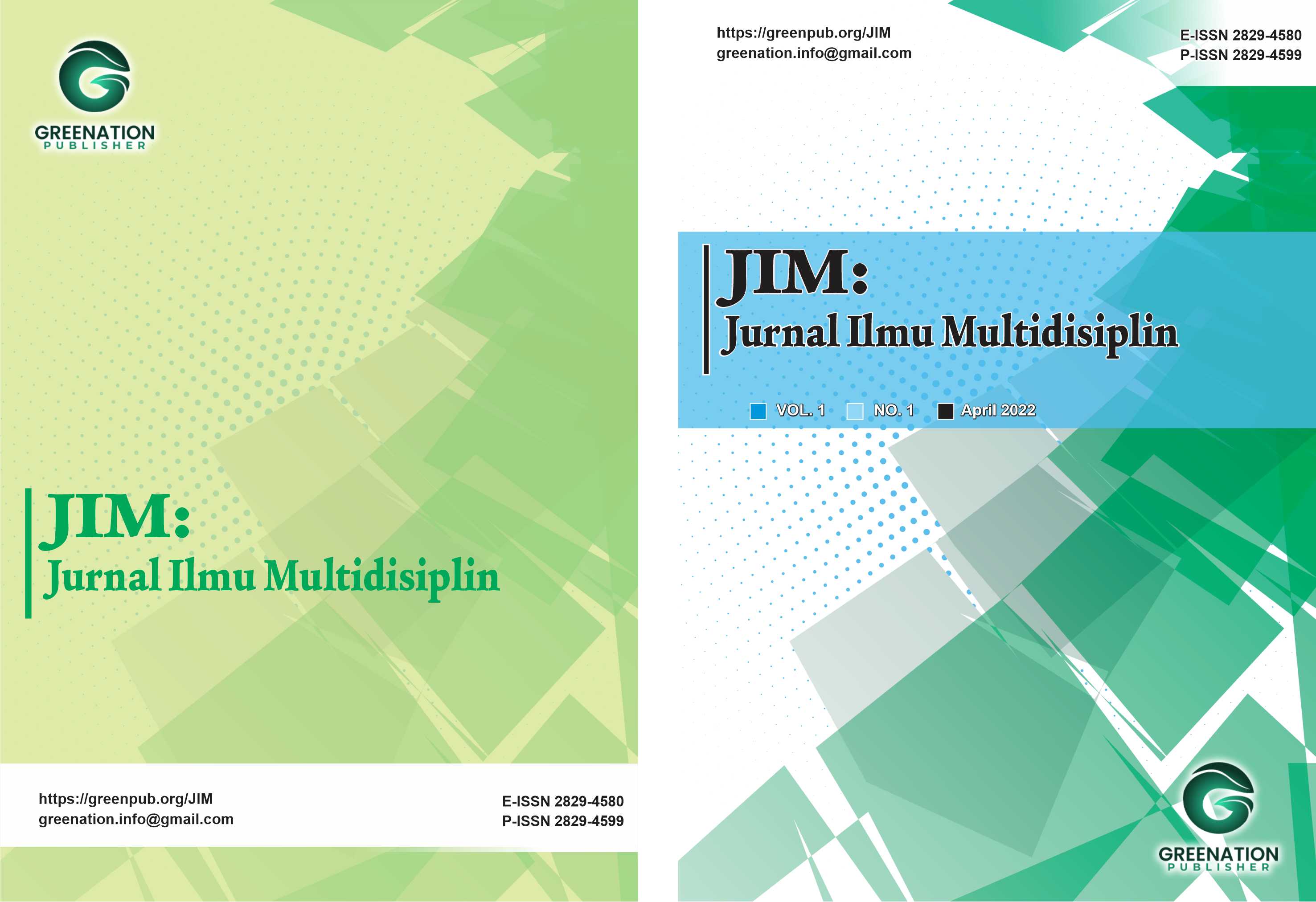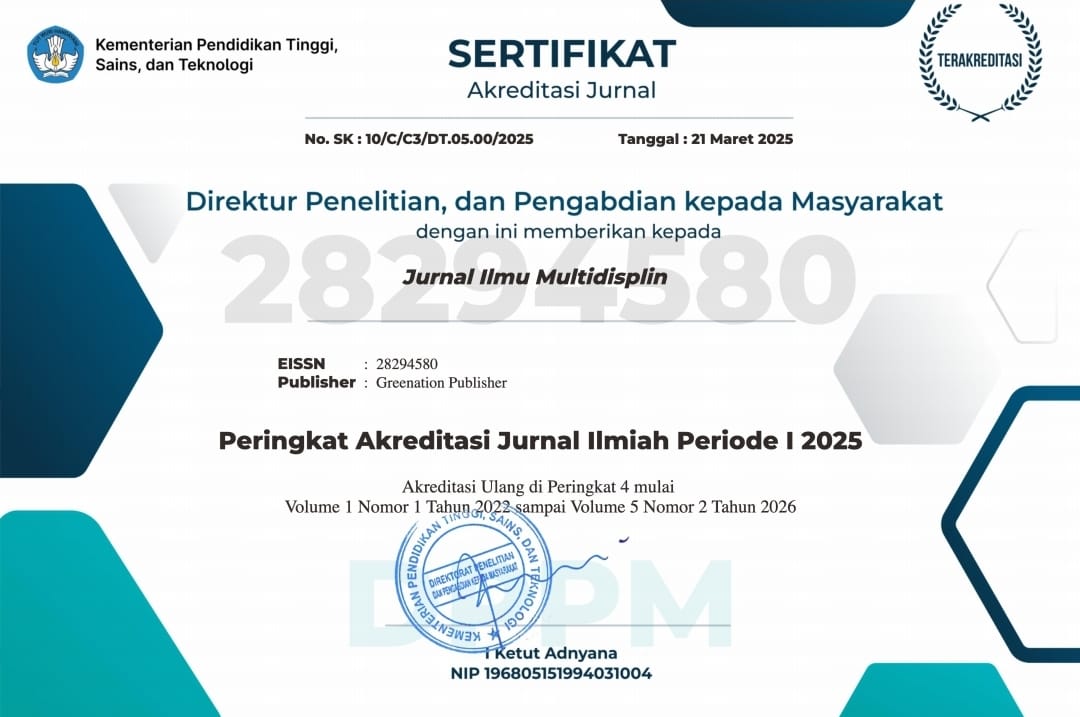The Role of Carboxymethyl Cellulose (CMC) from Durian (Durio zibethinus) Rind in Enhancing Coconut Milk Stability Under Different Temperature Condition
DOI:
https://doi.org/10.38035/jim.v4i2.908Keywords:
Stabilizing agent, CMC, Durian rind, Cellulose, Coconut MilkAbstract
The influence of carboxymethyl cellulose (CMC) concentration derived from durian rind (Durio zibethinus) and temperature variations on coconut milk quality was investigated through three stages. The first stage involved the isolation of ?-cellulose from durian rind powder, which was analyzed using FTIR to confirm its identity as cellulose. In the second stage, a series of processes including alkalization with isopropanol and NaOH, carboxymethylation with NaMCA, and neutralization using 90% CH3COOH and ethanol were conducted, followed by purification with distilled water, centrifugation, and the addition of acetone. This resulted in CMC, which showed positive qualitative analysis and FTIR peaks similar to those of commercial CMC. The final stage focused on coconut milk production, where CMC was incorporated at concentrations ranging from 0.5% to 0.7%, and temperature variations were set at 16ºC, 25ºC, and 80ºC. The quality of the resulting coconut milk was assessed for stability, pH, viscosity, moisture content, protein content, fat content, free fatty acid content, and organoleptic properties. The optimal results were achieved with the addition of 0.7% CMC at 16ºC, yielding a stability percentage of 34.78% with a shelf life of 9.5 hours, a pH of 6.21, viscosity of 12.6138 x 10² cP, moisture content of 45.81%, protein content of 7.57%, fat content of 43.51%, and free fatty acid content of 1.402%. Organoleptic tests indicated that panelists favored the coconut milk with 0.7% CMC for its color and aroma. The quality analysis results for the coconut milk with CMC addition and temperature variations met the existing SNI standards.
References
[BSN] SNI. 1995. Santan Cair. Badan Standarisasi Nasional. SNI 01-3816-1995. ICS 67.180.10.
[BSN] SNI.1992. Cara Uji Makanan dan Minuman. Badan Standarisasi Nasional. SNI 01-2891-1992. ICS 67.040.
Alemdar, A., and Sain, M., 2008. Isolation and Characterization of Nanofibers From Agricultural Residue-Wheat Straw and Soy Hulls. Bioresource and Technology. 99: 1664-1671
Andi, N.A. (2005). Virgin Coconut oil Minyak penakluk Aneka Penyakit. PT Agro Media Pustaka. Tangerang.
Anggraini, D.N. 2016. Penambahan Carboxymethyl Cellulose (CMC) Pada Minuman Madu Sari Apel Ditinjau dari Rasa, Aroma, Warna, pH, Viskositas, dan Kekeruhan. Jurnal Ilmu dan Teknologi Hasil Ternak. 11 (1): 59-68. Universitas Brawijaya.
Angkasa, S. dan Nazaruddin.(1994). Sukun dan Keluwih, Penebar Swadaya, Jakarta.
AOAC. 1980. Official Method of Analysis of The Association of Analytical Chemist. Washington DC.
ASTM. 2005. Analytical Method for Determining Degree of Substitution in The Product. Document Ck-G06 Edition, 05 : D-1439-03
Badan Litbang Pertanian. 2012. Indonesia Berpotensi Produksi Durian Sepanjang Tahun. Edisi 19-25 Desember 2012 No. 3487 Tahun XLIIII.
Bandung.
Belitz, H.D. and Grosch, W. 1987. Food Chemistry. Springer Verlag Berlin Heidelberg. Germany.
Bono, A., Ying, P.H., Yan, F.Y., Muei, C.L., Sarbatly, R. and Krishnaiah. 2009. Synthesis and Characterization of Carboxymethyl Celulose From Palm Kernel Cake. Advances in Natural and Applied Sciences. 3(1) :5- 11.
Bourne, M.C. 1982. Food, Texture, Viscosity, Concept and Measurement. Academic Press. London.
Cetakan I. Andi Offset. Yogyakarta.
Chiewchan N, et al. 2006. Effect of Homogenizing Pressure and Sterilizing Condition on Quality of Canned High Fat Coconut Milk. 73:38–44. J Food Eng.
COEI-1-CMC: 2009.OIV-Oeno 366-2009 and CAS 9004-32-4.
De Man, John. M. 1989. Kimia Makanan. Penerjemah Kosasih Padmawinata ITB.
Deviwings. 2008. The Science of Bakery Product. The Royal Society of Chemistry. Cambridge.
Direktorat Gizi Departemen Kesehatan RI. (1981). Daftar Komposisi Bahan Makanan. Jakarta
Fardiaz, S. 1986. Mikrobiologi Pangan I. Gramedia Pustaka Utama. Jakarta.
Fengel, D., and Wegener, G., (1995), Kayu : Kimia, Ultrastruktur, Reaksi-reaksi. Gajah Mada University Press. Yogyakarta.
Fennema, O.R. 1996. Principles of Food Science Part 1. Food Chemistry Incorporation. New York.
Fessenden. J., 1982. Kimia Organik. Erlangga. Jakarta.
Gonzalez, O. N. (1990). Coconut milk. In J. A. Banzon, O. N. Gonzalez, S. Y. de Leon, & P. C. Sanchez (Eds.), Coconut as food (pp. 15–48). Philippine Coconut Research and Development Foundation. Quezon City, Philippines.
Hardjono, S. (1995). Kimia kayu dasar-dasar dan penggunaannya. Edisi kedua. Gajah Mada University Press. Yogyakarta.
Hartomo, A.J. dan Widyatmoko M.C. (1993). Emulsi dan Pangan Instan Ber-Lesitin,
Hatta, V., 2007, Manfaat Kulit Durian Selezat Buahnya, Karya Ilmiah, Universitas Lampung.
Holtzapple, M.T. 1993. Cellulose: Encyclopedia of Food Science, Food Technology and Nutrition. Academic Press. London.
Hong, K.M. 2013. Preparation and Characterization Of Carboxymethyl Cellulose From Sugarcane Bagase. [Essay]. Malaysia : university Tunku Abdul Rahman. 1: 21-84.
Iswanto, B. 2009. Pengaruh Homogenisasi Terhadap Stabilitas Santan Awet dengan Penambahan Carboxymethyl Cellulose . [Skripsi]. Institut Pertanian Bogor.
Jayadas N, Nair K (2006). Coconut Oil as a Base Oil For Industrial Lubricants – Evaluation and Modification of Thermal, Oxidative and Low Temperature Properties. Tribol Int. 39:873-878
Kajs,T.M.,Hagenmaier,R., Anderzant,C and K.F.Matti l.1976. Microbiological Evaluation of Coconut and Coconut Products. Journal Food Science. 41:362-366
Kamal, N. 2010. Pengaruh Bahan Aditif CMC (Carboxyl Methyl Cellulose) Terhadap Beberapa Parameter Pada Larutan Sukrosa. Jurnal Teknologi. 1(2) : 123 – 129
Ketaren, S. 1986. Pengantar Teknologi Minyak dan Lemak Pangan. Cetakan Pertama. UI-Press. Jakarta.
Khalil, H.P, et al. 2001. The Effect of Acetylation on Interfacial Shear Strength Between Plant Fiber and Various Matrices. European Polymer Journal. 37(2001) 1037-1045.
Klemm, D.,Schmauder, H.P., and Heinze, T. 1998. Nanocellulose Innovative Polymers in Research and Application. Journal of Advance of Polymer Science. 205: 275-287.
Latif, A., Anwar, T., and Noor, S., (2007).,Two step Synthesis and Charactrization of Carboxymethylcellulose Rayon Grade Wood and Cotton Linter. Pcsir laboratories complex, material science centre, Pakistan.
Mandal, A. and Chakrabarty, D. 2011. Isolation of Nanocellulose from Sugarcane Bagasse (SCB) and Its Characterization. Carbohydrate Polymers. 86(1) : 1292 – 1299.
Marina, A.M., Man, Y.B.C., Nazimah, S.A.H., dan Amin. 2008. Monitoring the Adulteration of Virgin Coconut Oil by Selected Vegetabel Oils Using Differential Scanning Calorimetry. Journal of Food Lipids 16: 50–61.
McClements, D. J. 2005. Food Emulsions Principles, Practices, and Technique. CRC Press. Florida.
McKee, T. and McKee, J.R. 2003. Biochemistry: The Molecular Basis of Life. McGraw-Hill Companies, Inc. New York.
Meryandini, A., W. Wididari, B. Maranatha dan H. Satria. 2009. Isolasi bakteri selulolitik dan karakterisasi enzimnya. Institut Pertanian Bogor. Bogor.
Nacos, M., Katapodis, P., Pappas, C., Daferera, D., Tarantilis, P.A., Christakopoulus, D. 2006. Kenaf Xylan-A Source of Biologically Active Acidic Oligosaccharides. Carbohydrate Polymers. 66(1): 126-134.
Ohwoavworhua, F. 2009. Processing Pharmaceutical Grade Microcrystalline Cellulose From Groundnut Husk : Extrction Methods And Chracterization. International Journal of Green Pharmacy.
Palungkun, R. 1992. Aneka Produk Tanaman Kelapa. Penebar Swadaya. Jakarta.
Palungkun, R. 2005. Aneka Produk Olahan Kelapa. Penebar Swadaya. Jakarta.
Pangastuti H. 2016. Pengaruh Penambahan Berbagai Jenis Stabilizer (Tween 20, Alginat, dan CMC) dan Antimikroba (Kalium Sorbat, Kalsium Propionat dan Natrium Metabisulfit ) Terhadap Kualitas Fisik, Kimia, dan Mikrobiologi Santan Selama Penyimpanan 24 Jam. [Tesis]. Universitas Gadjah Mada.
Downloads
Published
How to Cite
Issue
Section
License
Copyright (c) 2025 Marina Wulandari Nasution, Juli Novita Sari

This work is licensed under a Creative Commons Attribution 4.0 International License.
You are free to:
- Share— copy and redistribute the material in any medium or format
- Adapt— remix, transform, and build upon the material for any purpose, even commercially.
The licensor cannot revoke these freedoms as long as you follow the license terms.
Under the following terms:
- Attribution— You must give appropriate credit, provide a link to the license, and indicate if changes were made. You may do so in any reasonable manner, but not in any way that suggests the licensor endorses you or your use.
- No additional restrictions— You may not apply legal terms or technological measures that legally restrict others from doing anything the license permits.
Notices:
- You do not have to comply with the license for elements of the material in the public domain or where your use is permitted by an applicable exception or limitation.
- No warranties are given. The license may not give you all of the permissions necessary for your intended use. For example, other rights such as publicity, privacy, or moral rightsmay limit how you use the material.




























